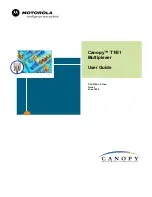
FMUX/SAT Multiplexer
© 2006 Cronyx
1.4. Connection Diagram
General diagram for connecting FMUX/SAT multiplexers to data transmission equip-
ment may be presented as follows:
E1 port
E1 port
Data
transmission
equipment
TXD-a,b
ETC-a,b
RTS
RXD-a,b
RXC-a,b
CD
DSR
CTS
DTR
E1 port
E1 port
TXD-a,b
ETC-a,b
RTS
RXD-a,b
RXC-a,b
CD
DSR
CTS
DTR
E1 port
E1 port
E1 port
E1 port
FMUX/SAT
FMUX/SAT
Fig. 1. Diagram for connecting FMUX/SAT multiplexer
to data transmission equipment
Multiplexed data from E1 ports are transmitted over group link via data transmission
equipment, and are demultiplexed at the opposite side. Positive digital justification is
used for frequency recovery in each separate E1 link.
An example of data transmission equipment may be satellite link and pair of satellite
modems operating in codirectional mode ("codirectional" principle suggests that data
and corresponding clock signal are transmitted at the same direction). In this case RXD
signal and RXC clock signal are transmitted from one multiplexer, and received as TXD
and ETC by another multiplexer.
The RXC signal is generated on basis of transmitting multiplexer internal clock, and is
used for synchronization during group link data reception by receiving multiplexer. It
is important that data transmission equipment should transmit this signal to ETC input
of receiving multiplexer transparently.
The FMUX/SAT multiplexer is DCE, and supports operation with CD, DSR, CTS, DTR,
and RTS modem signals.
The multiplexer uses the RTS signal loss for indicating the non-operating state of data
transmission equipment (in this case "LOS" indicator on the multiplexer lights).
The DTR does not affect operations of the device, but its state is shown on console.
Summary of Contents for FMUX/SAT
Page 43: ...2006 Cronyx 43...









































